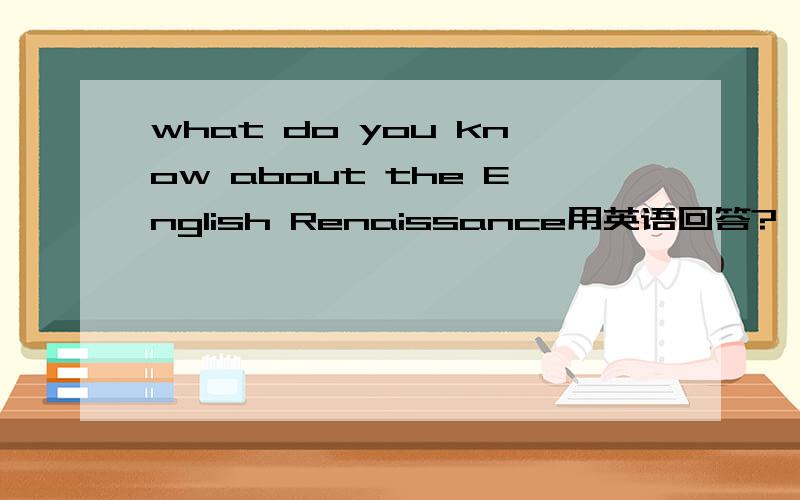what do you know about the English Renaissance用英语回答?
来源:学生作业帮助网 编辑:作业帮 时间:2024/05/11 00:54:45

what do you know about the English Renaissance用英语回答?
what do you know about the English Renaissance用英语回答?
what do you know about the English Renaissance用英语回答?
Leonardo da Vinci is a famous artist in the Italian Renaissance.
利奥纳多·达·芬奇是意大利文艺复兴时期的一位知名画家.
Florence is the shrine of the Renaissance.
佛罗伦萨是文艺复兴的圣地.
定义:
"English Renaissance" is a term often used to describe a cultural and artistic movement in England from the early 16th century to the early 17th century. It is associated with the pan-European...
全部展开
定义:
"English Renaissance" is a term often used to describe a cultural and artistic movement in England from the early 16th century to the early 17th century. It is associated with the pan-European Renaissance that many cultural historians believe originated in northern Italy in the fourteenth century. This era in English cultural history is sometimes referred to as "the age of Shakespeare" or "the Elizabethan era," taking the name of the English Renaissance's most famous author and most important monarch, respectively; however it is worth remembering that these names are rather misleading: Shakespeare was not an especially famous writer in his own time, and the English Renaissance covers a period both before and after Elizabeth's reign.
Poets such as Edmund Spenser and John Milton produced works that demonstrated an increased interest in understanding English Christian beliefs, such as the allegorical representation of the Tudor Dynasty in The Faerie Queen and the retelling of mankind’s fall from paradise in Paradise Lost; playwrights, such as Christopher Marlowe and William Shakespeare, composed theatrical representations of the English take on life, death, and history. Nearing the end of the Tudor Dynasty, philosophers like Sir Thomas More and Sir Francis Bacon published their own ideas about humanity and the aspects of a perfect society, pushing the limits of metacognition at that time. As England abolished its astrologers and alchemists, it came closer to reaching modern science with the Baconian Method, a forerunner of the Scientific Method.
English Renaissance
这与意大利文艺复兴有所不同
Comparison of the English and Italian Renaissances
The English Renaissance is distinct from the Italian Renaissance in several ways. First, the dominant art form of the English Renaissance was literature, while the Italian Renaissance was driven much more by the visual arts, such as painting and sculpture. Second, the English movement is separated from the Italian by time: many trace the Italian Renaissance to Dante or Petrarch in the early 1300s, and certainly most of the famous Italian Renaissance figures ceased their creative output by the 1520s. In contrast, the English Renaissance seems to begin in the 1520s, reaching its apex around the year 1600, and not concluding until roughly the restoration of Charles II in the 1660s. Finally, the English seem to have been less directly influenced by classical antiquity, which was a hallmark of the Italian Renaissance (the word "renaissance" means "rebirth," an allusion to the Italian belief that they were merely rediscovering or reviving lost ancient knowledge and technique); instead, the English were primarily influenced by the Italians themselves, and rediscovered the classical authors through them.
On the other hand, the Italian and English Renaissances were similar in sharing a specific musical aesthetic. In the late 16th century Italy was the musical center of Europe, and one of the principal forms which emerged from that singular explosion of musical creativity was the madrigal. In 1588, Nicholas Yonge published in England the Musica transalpina—a collection of Italian madrigals "Englished"—an event which touched off a vogue of madrigal in England which was almost unmatched in the Renaissance in being an instantaneous adoption of an idea, from another country, adapted to local aesthetics. (In a delicious irony of history, a military invasion from a Catholic country—Spain—failed in that year, but a cultural invasion, from Italy, succeeded). English poetry was exactly at the right stage of development for this transplantation to occur, since forms such as the sonnet were uniquely adapted to setting as madrigals (indeed, the sonnet was already well-developed in Italy). Composers such as Thomas Morley, the only contemporary composer to set Shakespeare, and whose work survives, published collections of their own, roughly in the Italian manner but yet with a unique Englishness; many of the compositions of the English Madrigal School remain in the standard repertory in the 21st century.
Not all aspects of Italian music translated to English practice. The colossal polychoral productions of the Venetian School aroused little interest there, although the Palestrina style from the Roman School had already been absorbed prior to the publication of Musical transalpina, in the music of masters such as William Byrd.
While the Classical revival led to a flourishing of Italian Renaissance architecture, architecture in Britain took a more eclectic approach. Elizabethan architecture retained many features of the Gothic, even while the occasional purer building such as the tomb in the Henry VII Lady Chapel at Westminster Abbey, or the French-influenced architecture of Scotland showed interest in the new style.
Major English Renaissance figures
The key literary figures in the English Renaissance are now generally considered to be the poet Edmund Spenser; the philosopher Francis Bacon; the poets and playwrights Christopher Marlowe, William Shakespeare and Ben Jonson; and the poet John Milton. Sir Thomas More is often considered one of the earliest writers of the English Renaissance. Thomas Tallis and William Byrd were the most notable English musicians of the time, and are often seen as being a part of the same artistic movement that inspired the above authors.
收起